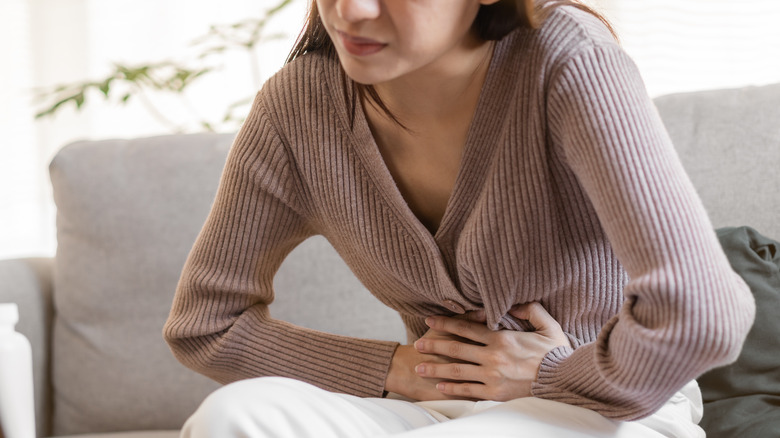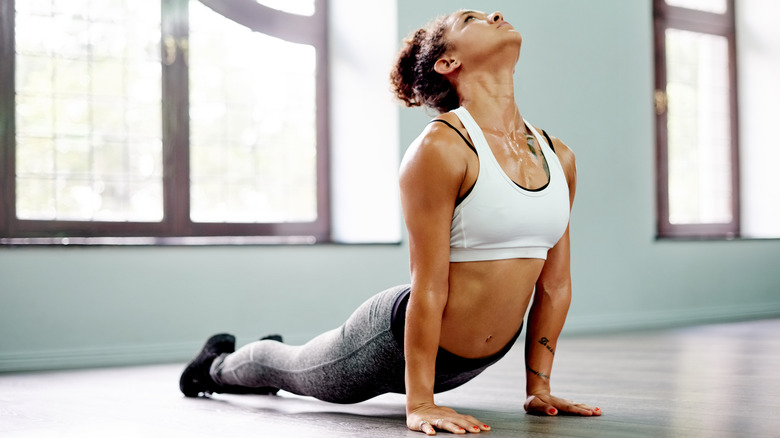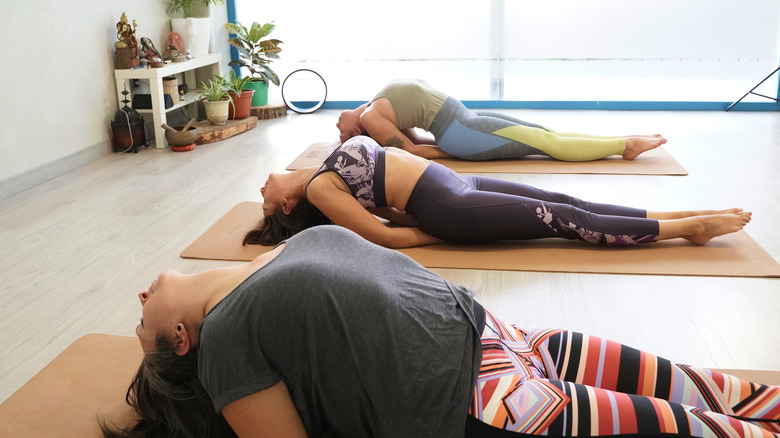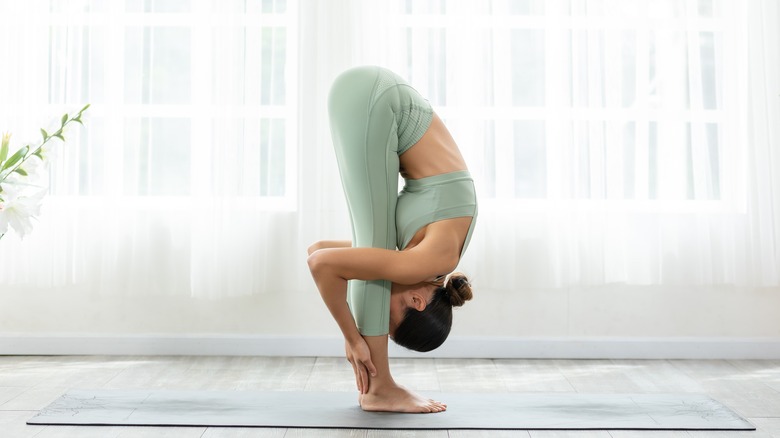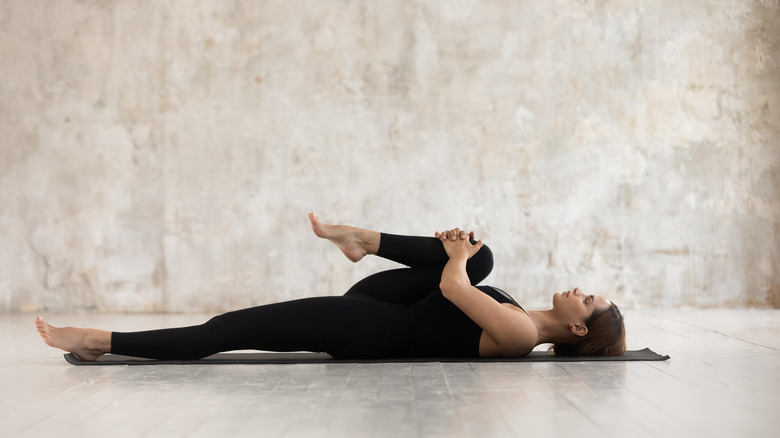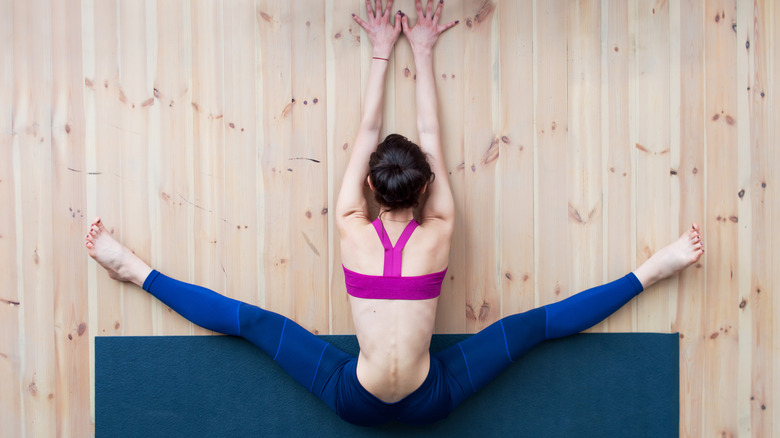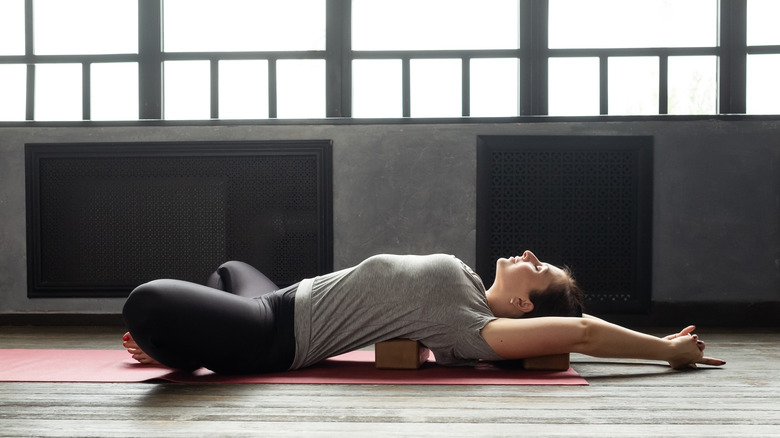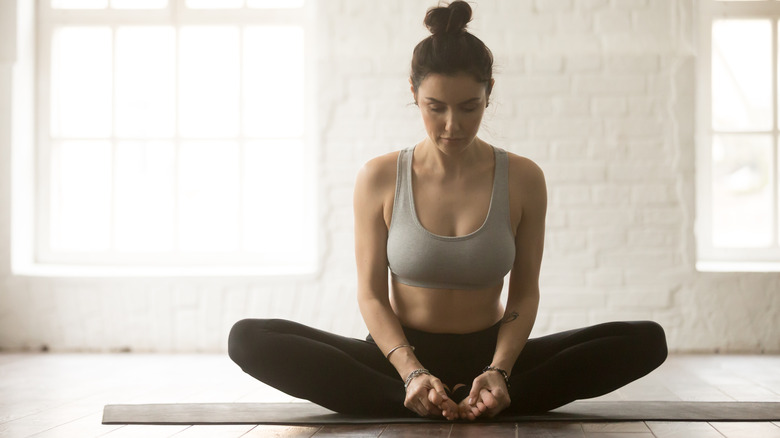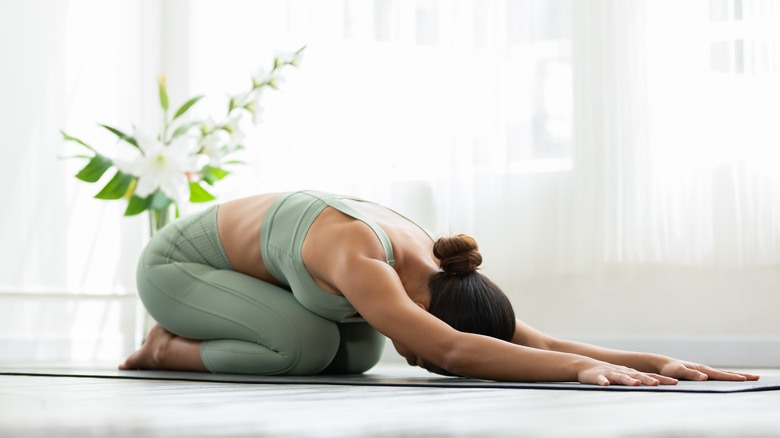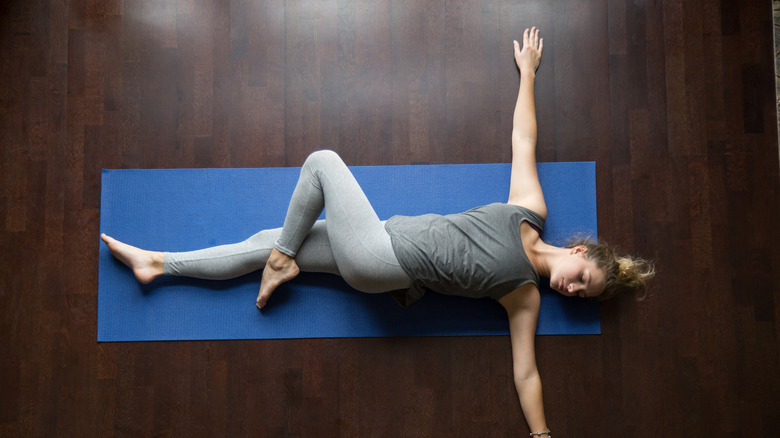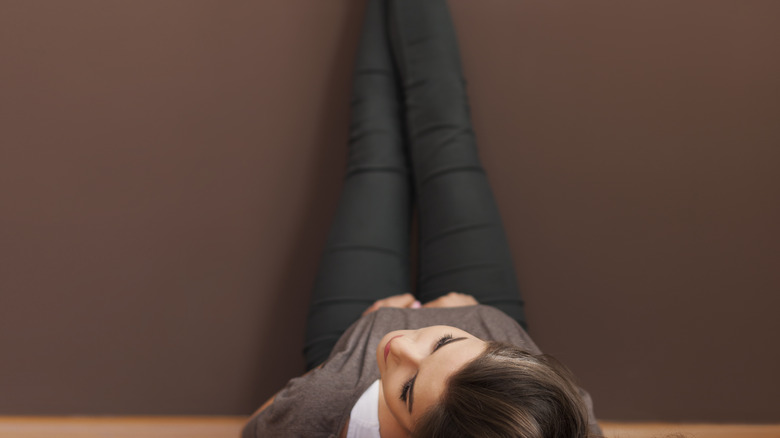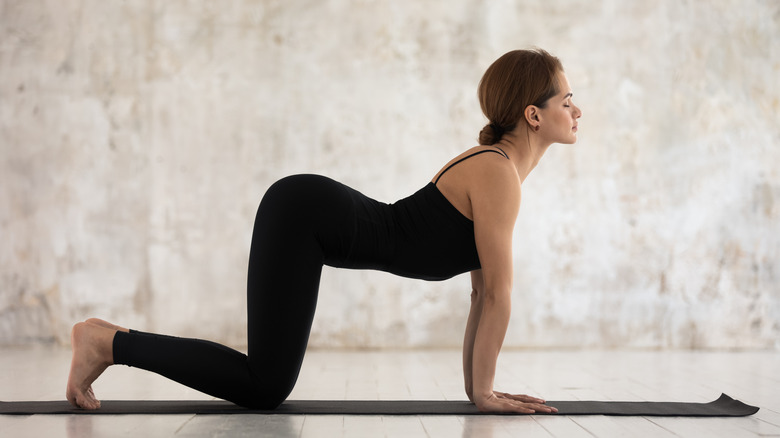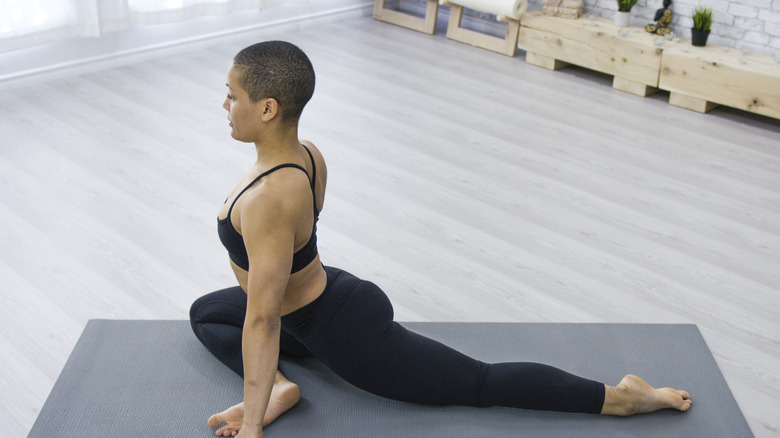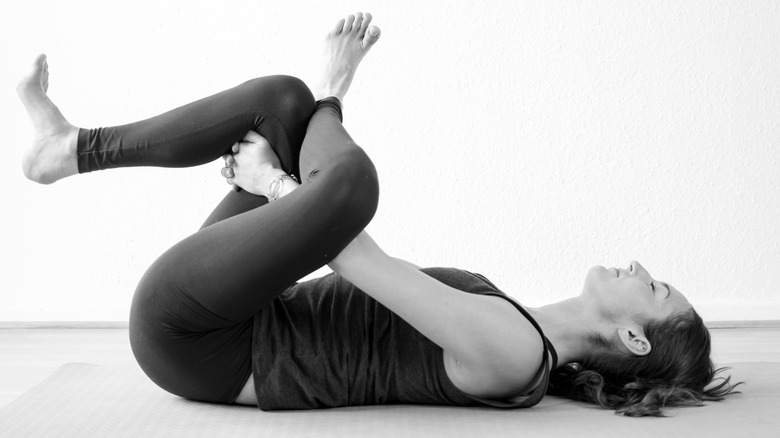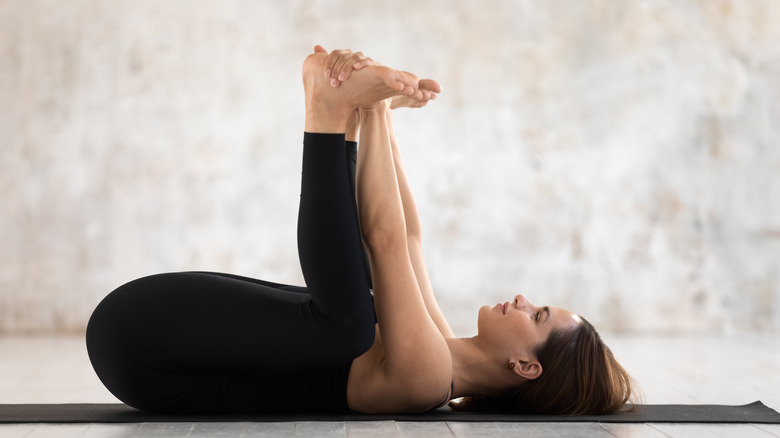14 Stretches That Can Help Bring Relief From Menstrual Pain
You're irritated, you're bloated, and your cramping has only just begun. Give it a few hours, and you may find yourself in a full-blown fetal position. We get it – PMS (premenstrual syndrome) is no joke. Surely, all you really want to do is pop a pain pill, curl up into a ball, and stay in bed. But it's important to get moving: Gentle, effective stretching can provide a well-rounded release of stress, tension, and that all-too-painful cramping.
There are various types of stretches to soothe the mood and lift your spirits while easing the pain. There are poses that may alleviate the severity of primary dysmenorrhea or period pain, according to a 2017 review in the Journal of Bodywork and Movement Therapies. Yoga combines breathing techniques and meditative or relaxing stretches that can reduce stress, improve fitness, and overall quality of life.
What's more, yoga stretches can have specific and overlapping benefits. For example, stretches that target the belly, pelvis, and hips may help reduce cramping, and gentle twists and folds may increase circulation as well as reduce bloat. So try these 14 stretches to get out of the doldrums and back to your daily routine.
1. Cobra stretch
While curling up into a ball may be your first instinct when period cramping starts, it need not be your only source of relief. In fact, a gentle back bending pose helps lengthen the spine and open the chest. This can provide several benefits, including strengthening the back, improving posture, and increasing flexibility to relieve tension and tightness that can exacerbate any pain. According to MyAvni.com, heart-opening poses like the cobra can reduce menstrual cramps by opening up those tight areas to encourage better blood circulation.
Lay flat on your stomach with your legs extended behind you. Press your palms along the sides of your rib cage. Then, press into your hands to lift your upper torso, expanding your chest. Lower down gently and repeat this sequence slowly and methodically. Tip: Instead of squeezing your butt, rotate your inner thighs upward to lengthen your tailbone. Doing so will take pressure off your lower back, per Yoga Journal.
2. Fish pose
Back bends may help release trapped energy in the body, according to Jessica Richburg Yoga. When energy gets stuck, it can trigger an emotional response, which triggers a heightened sensation of discomfort, pressure, or pain. Just consider the connection between nervousness and butterflies in the stomach.
The fish pose is a back bend stretch that can provide such a release. It also benefits you by targeting the hip muscles to reduce tension in the hip and lower back regions. And because tight hips contribute to lower back stiffness, you'll want to relieve those areas to promote a more fluid ease of movement.
Start by laying flat on your back with your legs extended and your arms by your sides. Tuck your chin slightly. Bring your forearms to your sides and press into your forearms and hands to open your chest; this will lift your upper body into a gentle back bend. Let the crown of your head rest on your mat. Place most of your weight on your hips and forearms, and root your legs firmly into the mat to enable a deeper stretch. Breathe deeply through this stretch and hold it for up to three minutes. Tip: Placing your hands below the buttocks may add support while allowing a deeper stretch.
3. Forward bend
Yoga practitioners often lead their students into forward bends for the benefit of grounding and calming the body. Grounding poses like this standing forward bend may be just what you need to mentally get through tough moments of pain and cramping. It is naturally calming to the parasympathetic nervous system, according to Heartmanity.
Breathing deeply and establishing a mindful, solid connection with the ground (i.e., experiencing the rooted sensation in your feet on the ground or the weight of your sit bones if seated) helps to mitigate the stress and strain associated with the cycle of pain, according to North Shore Myofacial Release. It may even release trapped emotions that contributes to your pain. What's more, a standing forward bend lengthens the spine and stretches the hips, which can reduce lower back pain often associated with period distress. It also promotes healthy circulation.
Deeply inhale as you stand upright with your shoulders back, your neck long, and the crown of your head to the ceiling. Exhale deeply as you bend your knees and gently hinge at your hips to fold your torso over your legs, reaching your fingers toward the ground. If your hamstrings are tight, bend your knees as deeply as necessary so as not to stress your lower back. Continue to breathe deeply as you lengthen through this stretch and allow the crown of your head to relax toward the floor.
4. Knee-to-chest
Bloating is one symptom of period discomfort. It may be exaggerated a week or two before your period and may even be present during your menses. The changes in progesterone levels before and during your period may cause the body to retain more water and sodium (per Medical News Today). What's more, these fluctuating hormones can make you gassy as well.
Knee-to-chest is a wind-relieving stretch that helps relieve gas and bloating. It works by gently massaging the abdomen to promote digestion and release trapped gas. Additionally, because it helps lengthen the spine, it is a great stretch for relieving lower back pain.
Lay flat on your back with your knees bent and feet flat on the floor. Clasp your hands above your right knee (at your lower thigh) and bring that knee toward your chest. Keep your lower back on the floor as you press into the mat with your grounded foot. Hold this stretch for 15 to 30 seconds. Then, repeat on the other side.
5. Seated straddle forward bend
If you aren't very flexible, a seated straddle may seem unrealistic and perhaps a bit painful. But hear us out. Modifying this pose by sitting on a block, straddling within your range (even if it is a narrow V), and bending your knees can give you the leverage you need to benefit from this stretch. In fact, this stretch will help relieve tight hip muscles and lengthen the spine to address back pain. So, if your period pain includes a sore lower back, this stretch is for you.
Roll up a towel or grab a block and sit on it to elevate your hip bones, especially if you have tight hamstrings. This will prevent rounding of the lower back and any jamming at the hip socket, according to Dani Winks Flexibility. Extend your legs forward and flex your feet (this is known as staff pose in yoga). Spread your legs out as wide as you can (and bend your knees as much as needed). Sit up tall and then fold at the hips as you walk your hands forward to stretch and lengthen your back. Breathe through this stretch for at least five to ten breaths.
6. Supine butterfly
Supine poses are beneficial for calming the mind, easing any stress, and starting from a position of little resistance. By providing a lower center of gravity, a supine pose is more supportive, which means it is easier to hold a stretch for a longer period of time. As well, starting from a relaxed state can help mitigate pain. This supine butterfly (bound angle) stretch helps to relieve tight hip flexors, which can put stress on the lower back muscles. It may also help relieve common period-related digestive issues such as constipation, according to Yoga Basics.
Lay flat on your back. Bend your knees with your feet flat on the mat. Bring your knees and feet together. Thread your hands between your legs to gently guide your knees open and your thighs toward the floor with the soles of your feet touching. Tip: For a more supportive stretch, place a pillow, rolled towel, or block below each outer thigh.
7. Bound angle (seated butterfly)
This seated pose is another one that is great for relaxing tight hips, as well as calming the nerves (via YogaU), which can be more frazzled during your period. This pose may also ease any digestive distress as well as stimulate the ovaries for better reproductive health, according to Lunette. It is interesting to note that the contraction of the uterus while it sheds its lining during menstruation may not only cause cramping but can also result in digestive issues such as constipation, nausea, or diarrhea, per the experts at Winnie Palmer Hospital.
Start by sitting in an easy cross-legged position. You can sit on a rolled towel or block to keep your lower back from rounding. Place the soles of your feet together and allow your knees to fall out to the sides. Tip: To provide support, you may place a pillow, block, or rolled towel below each thigh to ease any stress on the groin. Alternatively, bring your feet further in front of you to ease tightness by creating more space.
8. Child's pose
If you are feeling anxious during your period, opt for a child's pose to provide some grounding and calming relief. By "curling up into a ball," you are following your natural instinct to recoil with a purposeful stretch that can also provide digestive relief. According to Yo Re Mi, a simple variation to child's pose can also help reduce pressure and bloating.
Start in a kneeling position and sit on your knees. Hinge at your hips to draw your torso over your legs, keeping the weight of your butt on your heels. Keep your arms along your sides, palms facing up, and allow the crown of your head to gently rest on your mat. Or, walk your arms out in front of you as you lower your torso and head. Breathe through this stretch for at least 8 cycles of breaths. For a restorative variation: Keeping your toes touching, place a bolster between your knees and out in front of you. Then, fold over to rest your torso and head on the bolster.
9. Supine twist
If you've got cramping, the last thing you may want to do is move. But a gentle twist can help stimulate blood flow to nourish the pelvic region and reduce cramping, according to Yoga Journal. As a supine stretch, it also takes tension away from the neck, shoulders, and upper back. And as such, the supported posture may enhance a deeper, restorative stretch to help calm the nervous system.
Lay on your back with your arms stretched out to the sides to form the shape of a T. Extend your left leg and bend your right knee. Hug that knee toward your chest. Then, gently cross that right knee over your midsection to the left and toward the ground. If you can reach the ground without strain, use a pillow to support that knee. Keep both shoulders on the ground and breathe into that stretch. Then, return to your starting position and repeat on the other side.
10. Legs up a wall
Your period can come with some physical distress, not limited to cramping, constipation, and muscle and joint pain – including an achy back. If you are prone to back aches and cramping during your menses, stretching your legs up a wall can help. Legs up a wall will help lengthen the spine, stretch the hamstrings and glutes, and take the pressure off the lower spine, according to do you. It may also reduce cramping by allowing the pelvic muscles to relax and release.
Sit facing a wall with your hips close to the wall. Lay your torso down on the floor and walk your feet up to straighten your legs against the wall to form an L-position. You may have to shimmy to get your hip bones closer to the wall. But as comfort may dictate, it is okay to have more space between your hips and the wall. You can stay in this pose for as little as five minutes, or up to 20 minutes for a longer stretch.
11. Cat and cow
Soothe your period cramps and that achy back by bringing more blood flow (and thus, more oxygen) to the areas of discomfort.
Our organs and muscles rely on a steady source of oxygen for health and healing (via Dr-Ho's). The cat and cow stretches can relieve abdominal cramps by improving circulation to the area. Increased blood flow can also reduce stiffness by relaxing muscles to increase flexibility, as well as soothe those aches and pains, according to Pinnacle Pain and Spine. It will also ease lower back muscle tension by gently stretching those tight muscles surrounding your lower spine.
Start on your hands and knees. Be sure that your shoulders are directly over your wrists and that your hips are above your knees. Breathe in as you tilt your pelvis up while opening your chest and tilting your head upward. Exhale as you draw your belly in and simultaneously tilt your pelvis and crown of the head down, resulting in an arched spine. Repeat this sequence slowly and mindfully several times.
12. Pigeon pose
According to the Back Clinic, neuroscience suggests that emotional trauma may be stored in our hips. Emotional stress and trauma (though often felt in the neck and shoulders) can also result in hip pain. Whether or not you believe your emotions are stored in the hips, releasing tension in the hips can also relieve tightness that can worsen your cramps, according to Moreland OBGYN. Pigeon pose can provide the stretch needed to relieve tightness in the hips (and maybe even ease the mood from hormonal fluctuations).
Start on your hands and knees. Be sure that your shoulders are directly over your wrists and that your hips are above your knees. Bring your left knee forward, allowing your ankle to fall anywhere above your right hip. Slide your right leg back with your toes facing down and your heel toward the ceiling. Pull your hips together and keep them level. You may get a deeper stretch by walking your hands forward to lower your torso to the floor. Maintain a few deep breaths, return to the starting position, and then repeat on the other side.
13. Supine figure 4 stretch
The supine figure 4 stretch (also known as "thread the needle") is a gentle alternative to the Pigeon Stretch. As a hip opener, this stretch is also good for relieving lower back pain. And because you will have most of your body weight on the ground, it is a supportive and restorative stretch. Restorative refers to the ease and calm that come with performing the stretch. There will be plenty of time to incorporate deep, meaningful breaths and enough support to engage in a longer, deeper stretch.
Lay on your back with your knees toward the ceiling and your feet flat on the floor. Your feet should be hip-distance apart. Raise your right foot and place it below the knee of your left thigh. Then, place both hands around the left leg to pull both legs toward your chest, keeping that figure 4 position intact. You can hold this stretch as long as you like. Return your legs to starting position, and repeat on the other side.
14. Happy baby pose
Happy baby is another restorative stretch. It is great for promoting relaxation, in addition to being a good hip opener to reduce lower back tension. It stretches the hamstrings, groin, and inner thighs. This pose also provides gentle pressure to the sacrum, which protects the reproductive organs. Decompressing the sacrum may also aid in cramp relief. According to a 2020 study in the Journal of Rehabilitation Medicine – Clinical Communications, stimulation to the sacral region may help reduce lower abdominal pain associated with primary dysmenorrhea (period pain).
Lay on your back with your knees bent and simultaneously draw them toward your armpits. Flex your feet toward the ceiling, aligning your ankles above your knees (to form a 90-degree angle). Reach through your legs, grab the outside edge of each foot, and pull downward. Keep your lower back on the floor. Hold this pose for 30 to 60 seconds.

